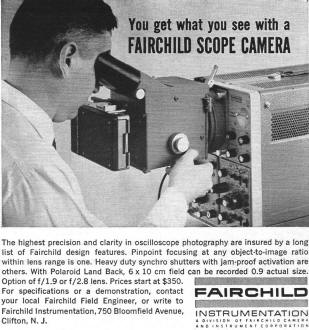Fairchild Instrumentation Scope Camera Advertisement |
|
Are you old enough to remember when in order to make a measurement on a circuit board it was necessary to physically connect an oscilloscope probe to a trace or component lead? "Wait," you say, "What are you talking about? You still do have to physically connect a probe." Right you are, but 50 years from now your progeny will be asking that question, just as today I ask you do you remember when in order to get a "screen shot" of an o−scope or spectrum analyzer display it was necessary to connect a camera to the front of the CRT? Some instruments had an(a) output port(s) for driving a pen plotter, but getting a plotter set up and calibrated was often more work and frustration than hanging a camera on the front. Most of the cameras used Polaroid film packs to enable "instant" pictures. Getting a good image usually took a couple tries. Scope cameras were still in common use when I entered the electronics world in the 1970s. It really wasn't until the later 1980s or early 1990s that printers could be hooked up to newer test instruments with a GPIB or parallel output port. Fairchild Instrumentation Ad
For specifications or a demonstration, contact your local Fairchild Field Engineer, or write to Fairchild Instrumentation, 750 Bloomfield Avenue, Clifton, N. J. Fairchild Instrumentation A Division of Fairchild Camera and Instrument Corporation
Posted November 1, 2018
|
|

